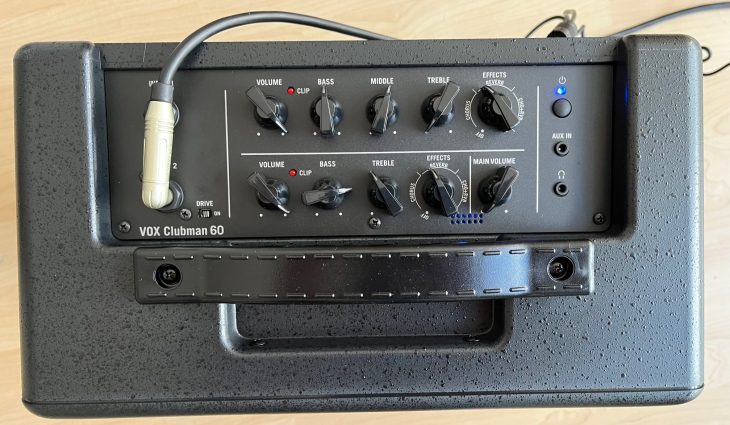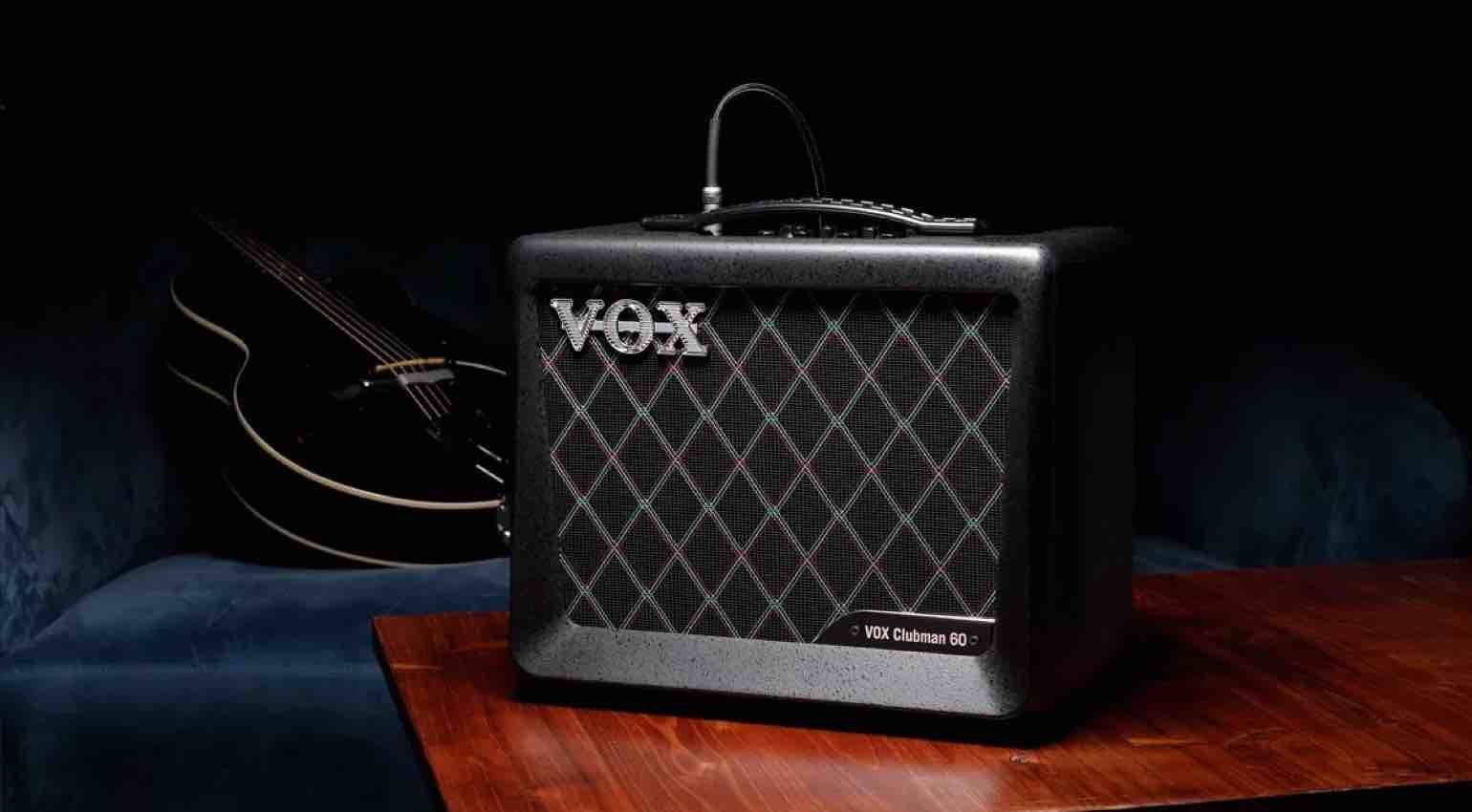Small, light and equipped with NuTube technology – is it the perfect jazz speaker?
October 31, 2023
VOX Clubman 60 – Facts and Features
the new Fox Clubman 60 It is a very compact and lightweight subwoofer. The assembled speaker made in Vietnam weighs only 4.6 kg. The question of how to achieve this is quickly answered if you take a closer look at the amplifier. No wood is used here, the speaker has a plastic casing. The question of whether this looks good at all will be answered during this test. The choice of ingredients is also important Fox New tracks for some time now. If you’re used to finding a tube in most amplifiers or multi-effects pedals from the legendary manufacturer, you’ll be taught otherwise, because the glass tube (usually an ECC83 or 12AX7) has been replaced by the so-called NuTube (Notetop 6P1) replacing. The component, which was developed and patented a few years ago, is said to be in no way inferior to the tube in terms of sound and dynamics. The energy consumption is therefore lower, because with the tube always needing to be “heated” with 6.3V, a large part of the energy required is simply converted into heat (hot). Maybe it will come when Clubman 60 The technology is very young and has been known for several years Amplifier tops It was then used and equipped with digital effects (chorus and reverb), housing and an 8-inch speaker.
Of course, our test object today is typical Fox– Design we’ve known since the 1960s (checkered front flap, chicken head buttons, etc.). The power of the integrated Class D power amplifier is 50 watts (not 60 watts, as one might expect from its name). The lightweight dimensions are just (W x D x H): 354 x 208 x 313 mm. The corresponding power supply (visually similar to a computer power supply) is included in the scope of delivery. Building Fox8-inch speakers with amplifier (2-way coaxial) then make the signal audible. The mini troll’s handle is also made of plastic, making it easy to transport the lightweight item. But this takes some time to get used to.

The rear view of the plastic body takes some getting used to
the Clubman 60 It has two independent channels or inputs. Channel 1 produces an exclusively clean sound, Channel 2 also provides overdrive sounds or can also be driven clearly using a small slide switch (Drive) if necessary. Switching channels would of course be desirable as well, which is especially welcome on stage so you don’t have just one sound to begin with. The option to save sounds or presets has been omitted here.
Apart from the two inputs for the instrument cable, we also find an AUX input (stereo mini jack), which can be used to mix music from a smartphone, tablet or other player if necessary. The playback volume must then be adjusted on the player, as there is no separate volume control for the AUX signal. This AUX input is always welcome when training. The unbalanced line output (6.3mm jack) outputs the captured signal behind the preamplifier, which can be fed to a mixer (PA), audio interface (recording), etc. If you want to practice quietly, the audio can be output via headphones (stereo mini jack), then of course the speaker is turned off.
Regulations
Channel 1 has a three-band tone control (bass, mid, and treble), while Channel 2 only has bass and treble control. Channel 2 can also produce distorted sounds by moving the small DRIVE slide switch to the correct position. The manufacturer should also consider adding a midrange control to channel 2, as this will also allow you to influence the midrange frequencies, which are very important for distorted sounds.
The output volume is determined by the main volume control. In order to adjust the desired volume ratio between the two channels, each of the two channels has a separate volume control. If the input level is too high, a small red LED will indicate this.

Intuitive operation, clear panel
Channel 1
It remains perfectly clean even when the volume (gain) control is fully open. The latter is likely used to adjust the volume relative to channel 2, which can also produce a slightly “dirtier sound”. It is best to start with a setup where the three tone control knobs are in the 12h position and then try to create the desired sound by making small changes. If you’re playing clean, we recommend adding some reverb to make the sound a little more spatial.
Channel 2
Provides maximum distortion in the “grind range” when the gain control is fully open (and the drive switch is activated). Since the “jazz player”, who usually prefers a “semi-hollow” or “hollow” guitar, essentially plays clean, more “noise” is probably not desirable at all. If necessary, you can add a distortion pedal (or other pedals) in front of it.
Built-in effects on Vox Clubman 60
If necessary, the sounds of both channels can be prepared independently with any amount or combination of reverb and chorus. Both effects are very popular with guitarists. By experimenting with controlling the effect, you can quickly achieve the desired result.
Video attachment from the manufacturer:
voice
According to the manufacturer, the small integrated amplifier is particularly recommended for semi-acoustic or “hollow-hole” guitar models (ES175 etc.), which is why the Gibson ES335 was used for the acoustic examples. In terms of sound, it cannot be determined that the plastic casing has a negative effect on the sound. First impression is positive.
In the first audio example, we hear the neck pickup of my Gibson ES335 with a subtle amount of integrated reverb. All tone control controls are set to 12 hours. Even with the gain control turned up, the sound remains quite clean, as you can hear here. For recording, the Sennheiser e609 was placed slightly to the side of the dome, and the signal went directly to the MOTU M4 audio interface and was recorded in Logic without any other effects (EQ, compressor, etc.).
You can hear it, the sound is balanced and warm. It’s not noticeable that there’s a plastic casing at first.
In the following example, the effect control is set to “Reverb+Chorus”. The voice is somewhat reminiscent of Mike Stern or Pat Metheny:
If the reverb control is turned to high, a pleasant spatial tone is created. The built-in echo sounds more than usable:
We now move to channel 2. The drive switch is activated, and the gain control is at full stop. With the bridge captured we get “blue distortion” in the crisis area:
NuTube’s patented technology sounds convincing, but it doesn’t quite achieve a tube sound like that produced by “real glass bulbs,” but the sonic result is still quite convincing. In the highs, you can notice that compared to a full-tube speaker, a certain final smoothness is missing. This may also be due to the built-in speakers with additional amplifiers. Since many guitarists prefer the Polytone Mini Brute for amplification for many years, and it is not a full tube amplifier, you can Clubman 60 Use it as a light, good-sounding alternative or even a successor.
I would like to conclude with a few comments about all-tube amplifiers and their alternatives:
Based on my experience with some test items using Korg’s NuTube technology, I can personally say that the sonic results are generally convincing. When compared with the ECC83, only marginal differences in sound can be seen. Aside from the amplifier’s components (tube, NuTube, transistor, operational amplifier, etc.), the interaction of all the components (power amplifier, speakers, speaker dimensions) is crucial to the overall sound of the subwoofer. If you want to know exactly in the end, you can only find out with the help of an individual comparison test. If you don’t notice any difference in sound or playing feel, there’s really no reason to choose a full-tube version, as this will always require more weight, not least because of the required transformers etc. Class D power amplifiers are also lighter, smaller, and cheaper to manufacture. The output volume of a tube power amplifier is relatively higher than what can be achieved with a Class D power amplifier of the same power. For “pure tube” glass bulb alternatives will probably not matter at all, although developments in the guitar amplifier sector are constantly advancing and “new” innovations such as impulse responses (IR) are achieving quite convincing results.
The audio examples were created with the following equipment:
Gibson ES335 – Fox Clubman 60 – Sennheiser e609 – MOTU M4 – Mac with Logic.

“Subtly charming coffee scholar. General zombie junkie. Introvert. Alcohol nerd. Travel lover. Twitter specialist. Freelance student.”








More Stories
Lia Maria Loeffler in the Golden Hall
Dirt Racing 24 comes with many improvements
Amazon offers one of the best video games of all time